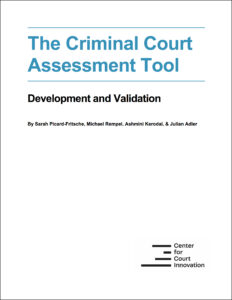-
Ashmini Kerodal
-
Julian Adler

Julian Adler
-

Michael Rempel
-
Sarah Picard

Sarah Picard
A brief assessment tool designed for high-volume criminal justice environments is a strong predictor of recidivism as administered to pretrial defendants in New York City, according to this comprehensive validation study. The report presents findings from a validation of the Criminal Court Assessment Tool—or C-CAT—a risk-and-needs assessment developed by the Center for Court Innovation in 2014. Unlike many such short assessments, the C-CAT identifies a defendant’s risk of re-offending and also ascertains the needs potentially fueling criminal behavior, facilitating referrals to effective interventions. The study also emphasizes the importance of local validation for jurisdictions considering adopting the tool.
The final C-CAT is a public domain assessment tool; email us to learn more.





